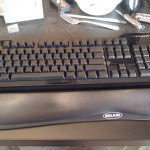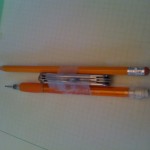 As you probably know, I got a Das Keyboard a little while ago, because my previous keyboard, which I liked very much, started getting a couple sticky keys. I'll freely admit I'm a keyboard snob, but I don't think it's terribly unreasonable given how much time I spend typing. Unfortunately, Das Keyboard has proven to be a complete piece of junk.
As you probably know, I got a Das Keyboard a little while ago, because my previous keyboard, which I liked very much, started getting a couple sticky keys. I'll freely admit I'm a keyboard snob, but I don't think it's terribly unreasonable given how much time I spend typing. Unfortunately, Das Keyboard has proven to be a complete piece of junk.
The action is great, the keyboard is attractive, it's heavy (no sliding). It's on the loud side, no question, but it's not terrible.
However, it doesn't type in the right order. There is some sort of bug in it's internal scanning that causes nearly-simultaneous keypresses to always be returned in a left-to-right order, regardless of what order they were actually pressed. And it's not a "sometimes" thing, it's perfectly repeatable.
When I first got the keyboard, I immediately noticed that I typed poorly with it. I didn't think much of it, since the action is quite a bit different than my last one, so I figured I just needed to get used to it. After a couple weeks, however, I wasn't improving, and I started to notice certain patterns in my errors.  After a bit more observation, I realized that the errors were all related to the spatial orientation of the offending keys.
For example, the word "keyboard" has the pairs "ke" and "oa" within it. These pairs are special because they are each typed with one finger from each hand. As such, it's very easy to type the letters in very rapid succession, even if you're not a particularly speedy typist. Further, you'll notice the right hand goes first.
The most damning example of this, of course, is the "he", in the word "the". A close second is BACKSPACE and any printable character. In this case, rather than reversing the letters, the printable character gets scanned first (all characters are left of the BACKSPACE), and then the BACKSPACE immediately deletes it, leaving the original erroneous character intact.
 Being a fan of science, I wanted to demonstrate this more objectively. To remove the human factor (at least most of it), I made a little test tool composed of two pencils strapped together with a pocket knife as a spacer. It puts the erasers exactly a key-width apart, so they'll press down neighboring keys. More importantly, one pencil is slightly higher than the other, so while they'll press down two keys, one key will be pressed slightly earlier than the other.
Being a fan of science, I wanted to demonstrate this more objectively. To remove the human factor (at least most of it), I made a little test tool composed of two pencils strapped together with a pocket knife as a spacer. It puts the erasers exactly a key-width apart, so they'll press down neighboring keys. More importantly, one pencil is slightly higher than the other, so while they'll press down two keys, one key will be pressed slightly earlier than the other.
Using this tool, aligning the "leading" pencil over the 'a', and the "trailing" pencil over the 's', a series of drops will look like this (taken with the tool, directly into the WordPress editor):
asasasasasasasasas
After flipping the pencil so the 's' key has the "leading" pencil, a series of drops looks like this (also taken directly into WordPress):
asasasasasasasas
As you can see, they are exactly the same! 'a' always preceeds 's', regardless of which order they are pressed in, as long as the separation between the two presses is small enough. This behaviour is not unique to the 'a' and 's' keys; it happens all over the keyboard, as long as the second letter key is to the left of the first key.
Manually retarding the drop so that the key presses have a larger delay between them results in correct behaviour, as expected.
Needless to say, I'm very disappointed in this supposedly "ultimate" keyboard.

